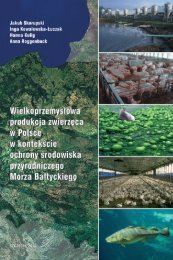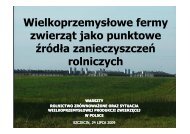best available technologies for manure treatment - Baltic Green Belt
best available technologies for manure treatment - Baltic Green Belt
best available technologies for manure treatment - Baltic Green Belt
Create successful ePaper yourself
Turn your PDF publications into a flip-book with our unique Google optimized e-Paper software.
Best Available Technologies <strong>for</strong> <strong>manure</strong> <strong>treatment</strong> baltic sea 2020<br />
Best Available Technologies <strong>for</strong> <strong>manure</strong> <strong>treatment</strong> baltic sea 2020<br />
ANNEX E: TABLES WITH SHORT DESPRIPTION OF LIVESTOCK MANURE TREATMENT TECHNOLOGIES<br />
Best Available Techniques <strong>for</strong> <strong>manure</strong> <strong>treatment</strong> - <strong>for</strong> intensive rearing of pigs in <strong>Baltic</strong> Sea Region EU Member States Technical Report "Best Practice Manure Handling, Phase 2"<br />
Ref No. 59 Algae production on liquid <strong>manure</strong> substrates<br />
Brief description Description of the effect on leaching (positive or negative) of N and P<br />
Pilot research has started in <strong>for</strong> instance Holland on the feasibility of algae production on<br />
liquid <strong>manure</strong> substrates. The challenging idea behind this is to utilise the facts that algae<br />
grows well in waters that are rich on plant nutrients, that algae in pilot studies has shown<br />
incredible high productivity levels, and that they are relatively easy to recover bioenergy<br />
sources from, in the <strong>for</strong>m of plant oil that can replace fossil fuels. Plant nutrients can be recirculated<br />
in the agricultural production, the P being of very high quality that could be used<br />
as feed ingredient.<br />
The expected effect is similar to that of the separation <strong>technologies</strong><br />
described above: The rest-fibre fraction would be possible to export to<br />
areas with low livestock density.<br />
The production would result in three components: Plant oil, a rest-fibre fraction and reject<br />
water, which dependent on local price conditions can be cleaned up to the economic optimal<br />
level.<br />
Innovation stage<br />
Investment price, <br />
Basic Variable<br />
Operational<br />
costs,<br />
per tonnes<br />
per kg saved<br />
N or P leaching<br />
Complexity of<br />
implementation<br />
Research <br />
Pilot<br />
No data No data No data<br />
Practice<br />
Major references<br />
Condition <strong>for</strong><br />
leaching<br />
reduction<br />
effect<br />
Certainty of in<strong>for</strong>mation<br />
No data Probably high<br />
CBMI Scenarios II - V<br />
Prices High<br />
Effect on leaching High<br />
78<br />
Side 80<br />
78








